Understanding digital ad sizes matters when determining the best marketing strategy to reach HCPs. Each ad unit has its best practices, from which device to use and where inventory will reach HCPs on the web to what type of media will help increase engagement. Different ad sizes can have varying levels of effectiveness in reaching healthcare professionals, grabbing their attention, and ultimately getting them to convert. By knowing which sizes resonate with healthcare professionals, advertisers can optimize their campaigns for better performance.
Below, we break down the top-performing ad sizes that healthcare professionals engage with the most by impressions, click-through rates, and conversion rates. Keep reading to better understand how to use the most effective ad sizes to improve your healthcare marketing.
Why Ad Sizes Matter When Engaging HCPs
Understanding which ad sizes healthcare professionals engage with online is crucial for creating more effective and targeted advertising campaigns. By measuring key performance indicators such as click-through rates (CTR), conversion rates, return on investment (ROI), and patient acquisition costs, marketers can determine which efforts are effective and how they need to pivot to optimize results. Additional analyses into the target audience that pinpoint demographics, interests, and user behavior can also help improve future campaign messaging so it can resonate better. This knowledge allows advertisers to better allocate resources, improve user experience, and ultimately achieve their marketing goals in the healthcare industry.
Adfire Health’s Digital Ad Size Data
The data used for this article was collected from January 2022 to September 2023 and obtained from Adfire Health’s demand-side platform (DSP). The research’s target population included 5.5 million healthcare professionals across more than 660 specialty types and more than 100 license types in all 50 U.S. states and six territories.
Over 957,279,995 impressions were captured across desktop, mobile, and tablet devices. Further, 1,303,679 unique NPIs were captured from 634 classes of healthcare professionals.
Digital Ad Sizes HCPs Engage With the Most
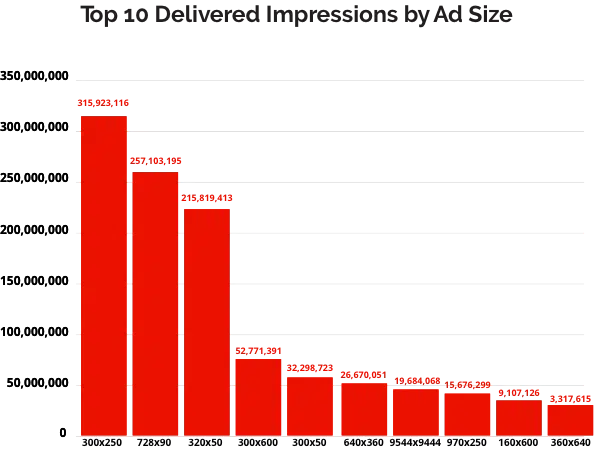
Ad Impressions Show How to Reach HCPs
Why Do Ad Impressions Matter?
An ad impression is a metric marketers use to determine how often a digital ad is shown on a user’s device. Ad impressions reveal available ad inventory and where HCPs spend their time online. HCPs see the following ad sizes the most frequently, as indicated by the top-performing ad sizes by delivered impressions:
- Medium Rectangle Ad: 300×250 pixels
- Leaderboard Ad: 728×90 pixels
- Mobile Leaderboard Ad: 320×50 pixels
- Half Page Ad: 300×600 pixels
Medium Rectangle Ad: 300×250
Also known as a “box ad,” the medium rectangle ad drove the highest delivered impressions at 325,923,116. This data reflects the medium rectangle ad is still one of the top-performing ads publishers use. It’s sizable enough to draw attention from website visitors without being overly intrusive, and it’s compatible with different ad formats, including video and responsive ads. By incorporating a compelling design and a clear call-to-action (CTA), advertisers can optimize their chances of capturing the audience’s interest and meeting campaign goals.

Where ads are placed: Medium rectangle ads are typically placed in the sidebar or within the content of webpages to effectively engage users without disrupting their browsing experience.
Why there is more inventory: This ad size is versatile and can be placed in various positions within a webpage on both desktop and mobile devices. Publishers often use this ad size, so more users are exposed to these ads and engage with them across devices.
Leaderboard Ad: 728×90
Leaderboard ads generated 257,103,195 impressions, which shows the ad size’s influence in reaching target audiences. Publishers often use leaderboard ads (728×90) due to their prominent placement at the top of web pages, which attracts user engagement and can lead to higher ad revenue, all while maintaining a positive user experience.
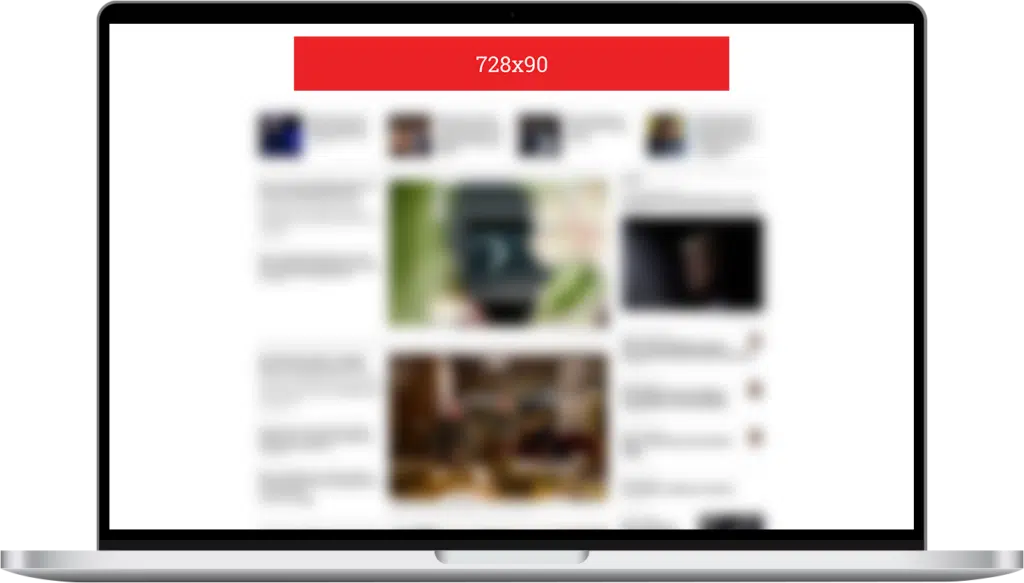
Where ads are placed: Leaderboard ads should be placed at the top of a web page, above the header or logo of the website. You can also maximize their effect by expanding the ad so the user can choose to see another panel with more detailed content.
Why there is more inventory: Leaderboard banners are a popular horizontal ad format known for their high visibility at the top of web pages. Since they are typically the first content users encounter when they visit a page, they can significantly grab the viewer’s attention.
Mobile Leaderboard Ad: 320×50 and 300×50
Mobile leaderboard ads sizes 320×50 and 300×50 also performed well. The 320×50 had 215,819,413 impressions, and the 300×50 generated 32,298,723 impressions. When strategically placed on mobile apps or web pages, these ad formats can provide users with a highly visible, attention-grabbing presence.

Where ads are placed: Designed specifically for mobile browsers and apps, this horizontal banner ad size is optimized for the bottom of smaller screens and can include text or images.
Why there is more inventory: Doctors are primarily browsing content on their mobile devices, so they’re more likely to see ads that are optimized for mobile and can naturally fit into a web page’s content.
Half Page Ad: 300×600
Half page ads generated 52,771,391 impressions, which shows users will engage with larger ad sizes that cover a significant amount of a web page if they are visually rich and offer compelling messaging without disrupting the flow of the content.
Why it performs well: Half page ads are large vertical ads that offer significant space for ad content on the margins. Across industries, they perform well due to their larger size, visibility, and adaptability.
When to use it: The half page ad size is well-suited for websites with ample vertical space. By using this format, publishers can effectively monetize their sites without impeding the browsing experience.
Click-Through Rates (CTR) Show HCP Engagement
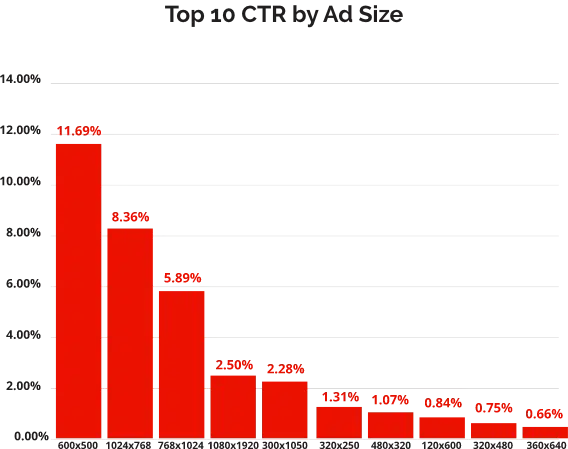
Why Do Click-Through-Rates Matter
Click-through rates (CTRs) reflect immediate healthcare professionals’ engagement and interest, indicating how effectively the campaign resonates with the target HCP audiences. A higher CTR often leads to cost efficiency, reducing the cost per click (CPC) or cost per acquisition (CPA) and optimizing the return on investment. CTRs offer valuable insights for ad testing and campaign optimization, enabling advertisers to refine their strategies and deliver relevant healthcare-related content to doctors more effectively.
Healthcare workers engage with the following ad sizes the most frequently, as indicated by the top-performing ad CTRs:
- Static Native Ad: 600×500 pixels
- Full-Page Tablet Landscape Interstitial Ads: 1024×768 and 768×1024 pixels
- Portrait Ad: 300×1050 pixels
Static Native Ad: 600×500
The 600×500 ads had the best CTR compared to other banner ad sizes, with mobile and PC browser CTR at 20%. These static native ads make a visual impact and offer users value without disrupting their browsing experience. A recent study showed native ads result in twice as much visual focus as banner ads on mobile devices and that most of the visual focus was on the ad’s text.

Why it performs well: Static native ads blend into the content within a webpage, making the user experience more seamless.
When to use it: Native ads are best suited for your target audience when they are relevant to the content on the web page. They should align with the content in context and design to create a seamless experience for the user. In-feed native ads are the most common form because they’re optimized for mobile devices and can include promoted listings and paid results.
Full-Page Tablet Landscape Interstitial Ads: 1024×768 and 768×1024
Full-page tablet landscape interstitial ads had a high CTR at 8.36%, which reflects how well these ads typically perform among tablet users. While these ad formats can be disruptive, their higher viewability combined with strategic messaging and design can greatly impact user engagement.
Why it performs well: Larger ads, such as the 1024×768 pixels ad, often yield a higher CTR because the ad covers the entire screen (or can be expanded to cover the screen).
When to use it: Larger ads are best suited for higher engagement, rich storytelling, and strong brand awareness campaigns targeted to specific demographics over conversion-driven campaigns. For instance, these banner ad sizes are perfect for visual storytelling between app experiences.
Caution: While CTR is high for HCPs, there is less inventory for this ad size. Most publishers use the more standard, smaller banner ad sizes because the larger ad formats can be intrusive and disruptive. CTRs may be increased because users click on the ad to get it off their screen rather than clicking on it because they are interested in the offering. They can also result in slower loading times, prompting users to click out of the page.
Portrait Ad: 300×1050
The portrait ad delivered a CTR of 2.28%, indicating that healthcare workers like engaging with larger ads if they offer relevant, interactive, and content-driven information. Portrait ads can include more content to be displayed without requiring users to scroll, enabling marketers to invest more in detailed product descriptions and storytelling while enhancing the user experience. Portrait ads are usually placed on the right-hand side of a website. Advertisers can use them to embed videos, rich media, and static content to drive engagement.

Why it performs well: Due to its larger size, these ads have great visibility and room for creative input to deliver high CTR.
When to use it: Portrait ads are particularly well-suited for campaigns that aim to engage mobile users and convey detailed information or compelling visuals in a vertical format. This can include product showcases and demos, brand narratives, event promotions, interactive infographics, and educational content.
View Through Conversions Show Lasting Impact
Why Do Conversion Rates Matter?
View-through conversions are a metric in digital advertising that track HCP conversions (e.g., requesting a free drug sample or meeting with a sales rep) after a HCP views an ad but does not click on it. Instead of clicking on the ad, the medical professional may have seen it and later performed the desired action through another channel or by directly visiting the advertiser’s website. View-through conversions are typically associated with display and video advertising campaigns. They are used to measure the impact of ad impressions on medical professionals’ behaviors, especially in situations where direct clicks are not the primary interaction point.
When the CTR for ad campaigns are low but the conversion rate is high, it’s because the healthcare professional came back at another time (i.e., a view-through conversion). Generally, the most widely used ads are the smaller ads (such as the 320×250 pixels ad). These tend to have higher conversion rates, even if they didn’t drive immediate CTR or engagements compared to larger ad formats. This indicates a more lasting impact on the user to make a more meaningful impact on the brand.
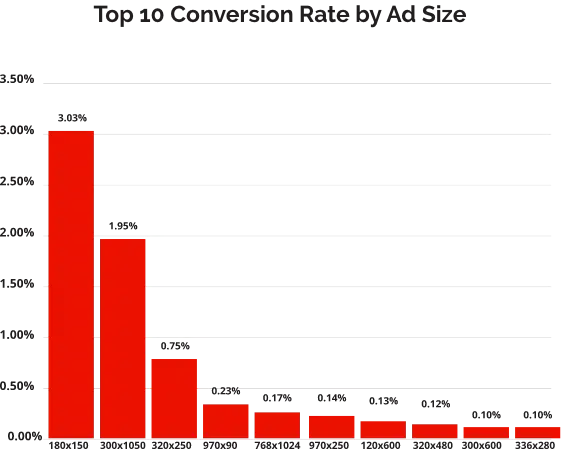
The top-performing ad sizes by conversion rate:
- Small Rectangle Ad: 180×150 pixels
- Portrait Ad: 300×1050 pixels
- Medium Rectangle Ad: 320×250 pixels
Small Rectangle Ad: 180×150
Small rectangle ads had the highest conversion rate at 3.03%, signaling users engage with smaller ads that are less obtrusive and directly convey value with focused messaging.
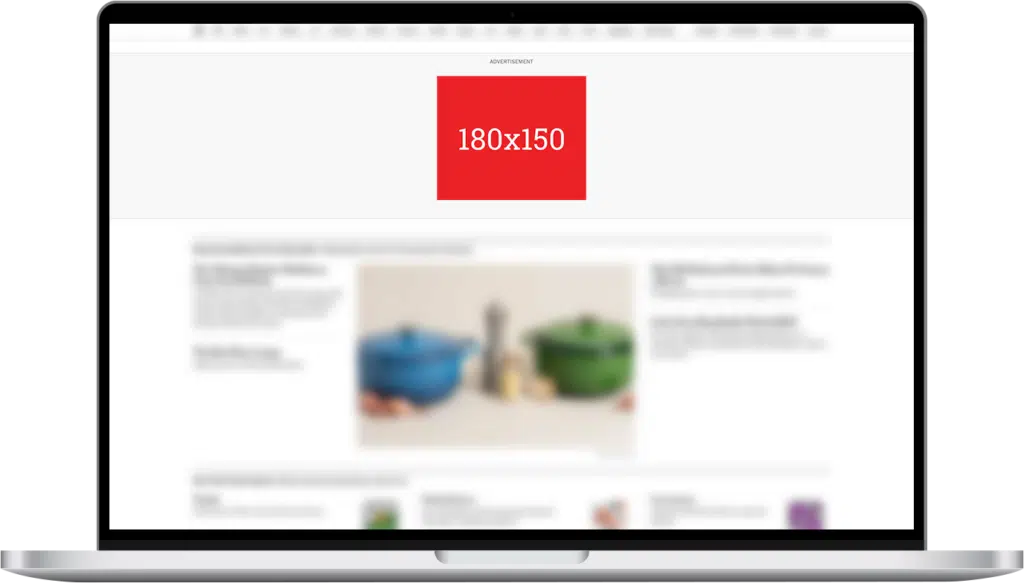
Why it performs well: The ad’s size is less likely to distract or overwhelm the viewer, leading to a more engaged audience that is more likely to convert.
When to use it: Small rectangle ads can be useful for mobile-optimized web browsers. If your website receives ample traffic from mobile devices, placing these small ads on multiple pages is best to boost engagement.
Portrait Ad: 300×1050
Portrait ads had a 1.95% conversion rate, mostly within mobile apps, showing our doctors engage well with larger vertical ads that share valuable, rich content.
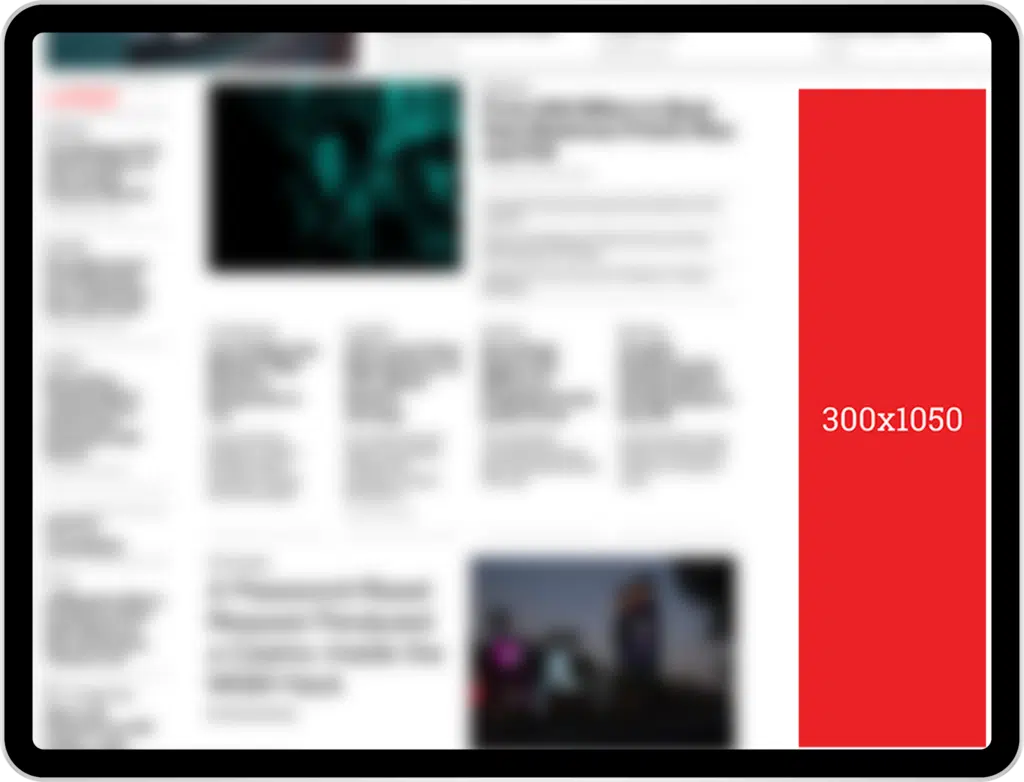
Why it performs well: Portrait ads can drive higher engagement and conversion rates due to their larger size. This increased visibility, particularly as a vertical ad, can catch the doctor’s attention, stand out amongst horizontal content, and increase the likelihood that they will stop and engage with the ad. Also, their size allows healthcare marketers to incorporate engagement features like calls-to-action, interactive elements like buttons or clickable areas, and informative content.
When to use it: Portrait ads are best suited for tablet-driven campaigns that aim to convey detailed information and impactful visuals to fully immerse the user and drive engagement.
Medium Rectangle Ad: 320×250
Medium rectangle ads drove a 0.75% conversion rate. Medical professionals respond well to this ad unit’s visibility, ability to integrate into the content, and mobile responsiveness.
Why it performs well: Medium rectangle ads are considered one of the top-performing ad units for advertisers, generating high clickthrough and conversion rates. Typically placed above the fold, they seamlessly combine text content with static or interactive media. Users are more likely to engage with them because they’re highly visible without being intrusive.
When to use it: The 320×250 size is well-suited for desktop and mobile devices and can be placed within articles, blog posts, or alongside other elements on a webpage to offer a smooth user experience. This ad format’s versatility makes it suitable for various campaigns. It can promote products and services, increase lead generation, or encourage specific actions like signing up for newsletters or purchasing.
Conclusion: Choosing the Right Ad Size to Engage HCPs
Understanding which ad sizes healthcare professionals engage with online is important for optimizing marketing efforts, improving user experiences, and ensuring that health care messages reach the right audience in a way that resonates with them. This knowledge can ultimately lead to better outcomes for advertisers and healthcare professionals.
At Adfire Health, we work with healthcare marketers to create optimized, highly effective, data-based digital engagement strategies. With Thumbprint™, our segmented data ecosystem of over 8.2 million healthcare professionals, we can offer direct access to healthcare professionals nationwide.
We bring our years of hands-on experience to every new campaign and work with you to get the best results possible. Contact us to learn more about what we can do for your business.
